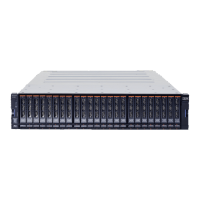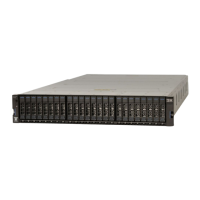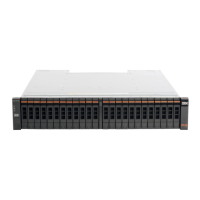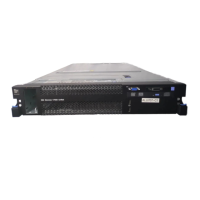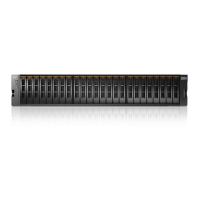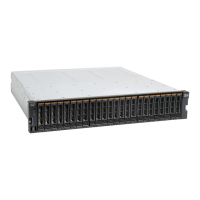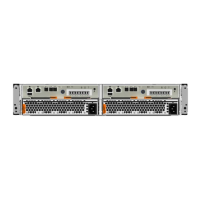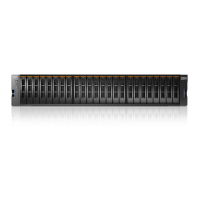If a LUN on an external storage system is the missing
quorum disk, it is listed it is listed as
WWWWWWWWWWWWWWWW/LL, where
WWWWWWWWWWWWWWWW is a worldwide port
name (WWPN) on the storage system that contains the
missing quorum disk and LL is the Logical Unit
Number (LUN).
User response: Follow troubleshooting procedures to
correct connectivity issues between the cluster nodes
and the quorum devices.
1. Check for any node errors that indicate issues with
bus or Fibre Channel connectivity. Resolve any
issues.
2. Check the status of other node canisters in the
system, resolve any faults on them.
3. Check all enclosures in the system are powered on
and that the SAS cabling between the enclosures
has not been disturbed. If any wiring changes have
been made check all cables are securely connected
and that the cabling rules have been followed.
4. If a quorum drive in a system enclosure is shown as
missing, find the drive and check that it is working.
The drive may have been moved from the location
shown, in that case find the drive and ensure it is
installed and working. If the drive is not located in
the control enclosure, try moving it to the control
enclosure, because a problem in SAS connectivity
may be the issue.
Note: If you are able to reestablish the systems
operation you will be able to use the extra
diagnostics the system provides to diagnose
problems on SAS cables and expansion enclosures.
5. If a quorum disk on an external storage system is
shown as missing, find the storage control and
confirm that the LUN is available, check the Fibre
Channel connections between the storage controller
and the 2076 are working and that any changes
made to the SAN configuration and zoning have
not effected the connectivity. Check the status of the
Fibre Channel ports on the node and resolve any
issues.
6. If a quorum disk on an external storage system is
shown as missing, find the storage control and
confirm that the LUN is available, check the Fibre
Channel connections between the storage controller
and the system are working and that any changes
made to the SAN configuration and zoning have
not effected the connectivity. Check the status of the
Fibre Channel ports on the canister and resolve any
issues.
7. If all canisters have either node error 578 or 550,
attempt to reestablish a cluster by following the
service procedures for the nodes showing node
error 578. If this is not successful, follow the cluster
recovery procedures.
556 A duplicate WWNN has been detected.
Explanation: The node canister has detected another
device that has the same World Wide Node Name
(WWNN) on the Fibre Channel network. A WWNN is
16 hexadecimal digits long. For a Storwize V7000, the
first 11 digits are always 50050768020. The last 5 digits
of the WWNN are given in the additional data of the
error. The Fibre Channel ports of the node canister are
disabled to prevent disruption of the Fibre Channel
network. One or both node canisters with the same
WWNN can show the error. Because of the way
WWNNs are allocated, a device with a duplicate
WWNN is normally another Storwize V7000 node
canister.
User response:
1. Find the Storwize V7000 node canister with the
same WWNN as the node canister reporting the
error. The WWNN for a Storwize V7000 node
canister can be found from the node Vital Product
Data (VPD) or from the node canister details shown
by the service assistant. The node with the duplicate
WWNN need not be part of the same cluster as the
node reporting the error; it could be remote from
the node reporting the error on a part of the fabric
connected through an inter-switch link. The two
node canisters within a control enclosure must have
different WWNNs. The WWNN of the node canister
is stored within the enclosure chassis, so the
duplication is most likely caused by the
replacement of a control enclosure chassis.
2. If a Storwize V7000 node canister with a duplicate
WWNN is found, determine whether it, or the node
reporting the error, has the incorrect WWNN.
Generally, it is the node canister that has had its
enclosure chassis recently replaced or had its
WWNN changed incorrectly. Also, consider how the
SAN is zoned when making your decision.
3. Determine the correct WWNN for the node with the
incorrect WWNN. If the enclosure chassis has been
replaced as part of a service action, the WWNN for
the node canister should have been written down. If
the correct WWNN cannot be determined contact
your support center for assistance.
4. Use the service assistant to modify the incorrect
WWNN. If it is the node showing the error that
should be modified, this can safely be done
immediately. If it is an active node that should be
modified, use caution because the node will restart
when the WWNN is changed. If this node is the
only operational node in an enclosure, access to the
volumes that it is managing will be lost. You should
ensure that the host systems are in the correct state
before you change the WWNN.
5. If the node showing the error had the correct
WWNN, it can be restarted, using the service
assistant, after the node with the duplicate WWNN
is updated.
556
Chapter 9. Event reporting 145
